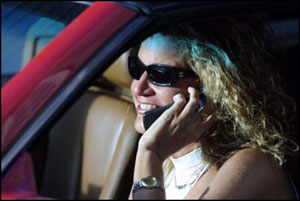With cell phone and mobile data usage increasingly on the rise and expected to become more vital to Bay Area residents and businesses, providers are working on enhancing their coverage in Morgan Hill and surrounding areas.
The Morgan Hill planning commission last week approved land use permits to allow the replacement of six cell towers and installation of accompanying equipment at two sites in the city limits – the city’s water tank at West Fourth Street, and the 127-foot-tall water tower on Madrone Parkway that is privately owned and no longer used for water storage, according to city staff.
The commission is expected to consider another application for the construction of three new cell service antennae at a site on Vineyard Boulevard in the coming weeks.
All of the new facilities will serve Sprint mobile users exclusively, but other companies and city staff say there is a widespread effort under way to keep up with the demand of a growing number of customers connecting to increasingly advanced network systems.
Morgan Hill associate planner Steve Golden said based on his ongoing discussions with telecommunication industry representatives seeking to install or upgrade cell towers, some of the antennae put up in the last five to 10 years are reaching their full capacity.
The issue is not the coverage of the area, but the ability to handle the voice and data usage of existing customers within the area, Golden said.
“(Some experts) didn’t anticipate even five years ago that everybody was going to have a smartphone, a tablet, and their kids were going to have smartphones,” Golden said.
The inability of the network to meet the burden of more users means more customers experience dropped or blocked calls, or slower data download speeds.
In Sprint’s case, the company is in the process of implementing a service upgrade plan announced earlier this month to expand its 4G LTE network to 20 more cities nationwide, including San Francisco and other Northern California cities, according to Sprint communications manager Caroline Semerdjian.
“As part of its overall network strategy, Sprint is also doing a complete overhaul of its 3G infrastructure so that customers can enjoy better wireless signal strength, in-building coverage and fewer dropped or blocked calls,” Semerdjian said.
The 4G network uses more advanced technology than the 3G network, and allows significantly faster and more data usage, according to industry experts. As it is a relatively new network that is growing in popularity, most telecommunications providers are still in the process of upgrading their antennae and other facilities to accommodate the nationwide demand.
Nationwide, more than 91.4 million people own and use smartphones, which are capable of connecting to the 3G and 4G networks, according to a study earlier this year by Nielsen Research.
In Morgan Hill, Sprint has completed a total of 34 network upgrades at its existing Morgan Hill cell tower sites in the last six months, Semerdjian said.
“Dozens more are planned through the second quarter of 2013,” she added. The company is replacing its existing cell towers rather than erecting new ones in its plan to improve signal strength.
Another provider, AT&T, recently added a new cell tower at Monterey Road and Kirby Avenue to improve usage capacity in Morgan Hill, according to AT&T spokeswoman Stephanie Rosa.
“We’re constantly looking for ways to improve the network to bring customers the best possible coverage,” Rosa said.
The planning commission will next consider Sprint’s use permit amendment request for the site at Vineyard Boulevard at the Nov. 13 meeting, Golden said.
Sprint plans to install three new antennae there, adding to the three it currently owns at the site.
Many of the sites contain existing cell network infrastructure operated by multiple carriers.
The site at Vineyard, for example, currently hosts a total of 18 antennae owned by Sprint, AT&T, Nextel and Metro PCS, according to city staff.
Cell companies often contract with outside leasing agencies to pursue cell tower sites and close deals with land owners, Golden said.
The city leases some of its property to cell providers. These include sites with higher altitude and places where the cell towers are “not necessarily causing another significant impact for the property owner,” Golden said.
In 2011, the city collected more than $75,000 in revenue from lease payments on these publicly owned sites, according to Morgan Hill program administrator Anthony Eulo.








